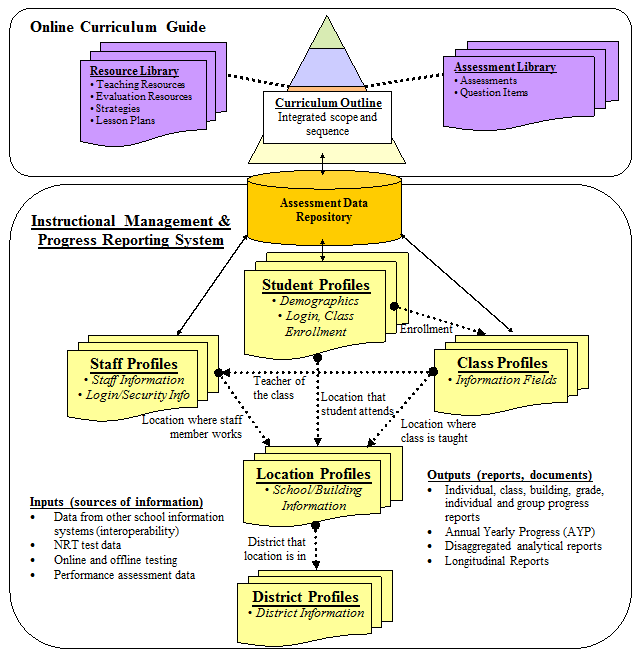Organization of Information
The following diagram presents the primary organization of information in PowerSchool Special Programs.

PowerSchool Special Programs stores information on students, staff, classes, locations, and districts in profiles. Depending on how you are using the system, there are at least four main types of profiles:
- Location profiles - There is one location profile for each school, building, or site where students can receive instruction. The profile contains fields that describe a location, such as location ID, location name, address, phone number, and other information that differentiate and describe each location.
- District profiles, County profiles, Region profiles, etc. - These types of profiles describe hierarchical groupings of schools within the organization. If a student is sent or received from outside the organization, the scope may include these outside organizations. For example, if students are sent to or received from other school districts for instruction or special services, the information on the outside districts is maintained. District profiles contain fields that describe a school district, such as district code, district name, and district contact.
- Staff profiles - Each teacher, administrator, or other staff member involved in the instructional process has a staff profile. The staff profile contains security information (login, password, security group membership) and information, such as name, phone number, staff position, work location.
- Student profiles - Generally, there is one student profile for each student enrolled in the school district. Each student profile contains demographics, such as ID, name, sex, birth date, and academically-oriented information, such as grade level, class enrollment, services received, and enrollment start date. If student/parent logins are enabled, student profiles also contain security and login information for both the student and the parents of the student. In addition, the previous figure shows that each student profile includes an evaluation profile that maintains student performance data relative to the curriculum guide.
- Class profiles - This type of profile is the basis for student enrollment in classes. A class profile represents an individual teacher teaching a particular content area to a specific group of students. It contains information that describes the class, such as class name, teacher(s), program (subject area), building identifier, room number, and period.
The figure above illustrates the types of profiles and the relationships between them. For example, the figure shows that each class profile references (is linked to) the staff profile of the person teaching that class. By default, teachers can only access the students in their classes (unless they have additional privileges). Similarly, the student profiles, class profiles, and staff profiles reference the location profile of their respective school or site. By default, staff can only access information from their location unless they have system-wide access privileges.
A subset of data maintained in profiles is typically populated directly from the school district's primary Student Information System (SIS) using an interoperability mechanism appropriate for that school district. The Data Connectivity Tool (covered in the "Data Connectivity Guide") is used to establish a periodic transfer of data between the systems.
The previous figure shows how the curriculum guide fits into the overall system. Maintenance of curriculum is covered in Curriculum Development. While perhaps not directly responsible for the curriculum, system administrators should be aware that the "assessment repository" shown in the figure contains score information relative to the curriculum and historical values of key demographic fields required for longitudinal analysis and mandated reporting.
